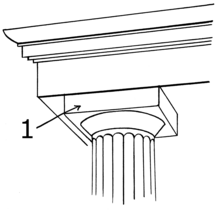Bowtell
Appearance

Bowtell is derived from the medieval term bottle;[1] in architecture it refers to a round or corniced molding below the abacus in a Tuscan or Roman Doric capital; the word is a variant of boltel, which is probably the diminutive of bolt, the shaft of an arrow or javelin. A roving bowtell is one which passes up the side of a bench end and round a finial, the term roving being applied to that which follows the line of a curve.[2]
Notes
- ^ Treatise on architecture:..., ed. Arthur Ashpitel, p. 94, (Edinburgh 1867). A round molding can also be referred to as a torus.
- ^ One or more of the preceding sentences incorporates text from a publication now in the public domain: Chisholm, Hugh, ed. (1911). "Bowtell". Encyclopædia Britannica. Vol. 4 (11th ed.). Cambridge University Press.
